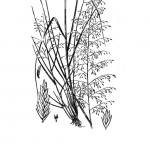Sand Lovegrass
Eragrostis trichodes (Nutt.) Alph. Wood
Poaceae
Description
A tufted, erect bunchgrass. Branches are straight, rough-textured, green to reddish-purple in color, and diverge multiple times from the central stalk (i.e., rachis). Sheaths are hairy at the throat. The ligule is a fringe of hairs about 0.5 mm in length. Nodes are hairless. Leaves turn to a rusty-tan color when dormant. The panicle is 1 to 2 feet or 0.3 to 0.6 m long, oblong, and open, with purplish to pale spikelets bearing six to ten flowers. The spikelets are in clusters at the tip of the seed branches. Spikelets mature in late summer through fall. Mature seeds fall away individually along with the lemma. The seeds are golden to reddish brown in color, round to squarish in shape, slightly flattened, 0.8 to 1.5 mm long, and have a distinct groove on one side. Sand Lovegrass is a perennial, warm-season, native ranging from 2 to 5 ft or 0.6 to 1.5 m tall. It is valued for its fine, purplish inflorescence and arching habit. Good forage for wildlife. Excellent forage for livestock during spring and early summer, fair to good forage after the plant matures. Highly palatable and known as an ice-cream grass of the prairie.Habitat
Grows on the upland, sandy soil of prairies, rocky slopes, roadsides, and open woodlands. A good grass for livestock grazing when managed as a pure stand. Sand Lovegrass is adapted to heavier soils and is used for stabilizing sandy areas.Images
Plant Characteristics
Duration: Perennial
Stem Texture: Hairy
Growth Habit: Bunch grass, Grasses
Leaf Shape
 : Simple with Pinnate or Parallel Venation
: Simple with Pinnate or Parallel Venation
Season: Warm
Distribution
 : 01 - Pineywoods, 03 - Post Oak Savannah, 04 - Blackland Prairies, 05 - Cross Timbers and Prairies, 06 - South Texas Plains, 07 - Edwards Plateau, 08 - Rolling Plains, 09 - High Plains, 10 - Trans-Pecos
: 01 - Pineywoods, 03 - Post Oak Savannah, 04 - Blackland Prairies, 05 - Cross Timbers and Prairies, 06 - South Texas Plains, 07 - Edwards Plateau, 08 - Rolling Plains, 09 - High Plains, 10 - Trans-Pecos
Distributions
Distribution refers to the ecological region in Texas that a plant has been found. You can also view a clickable map.
Book: Know Your Grasses (B-182)
Collection: Grasses


